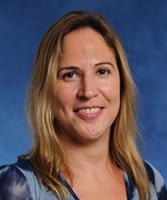Securing the Cloud

Assistant Professor Susan Hohenberger, of the Department of Computer Science, works on Practical Cryptography for the Cloud. Hohenberger develops cryptographic schemes for the cloud environment, including methods to protect the privacy and integrity of data for the growing number of consumers who use cloud services.
She joined Hopkins in 2007 after receiving her PhD in computer science at MIT and working as a postdoc at IBM Research in Zurich, Switzerland. At MIT, she worked under Ronald Rivest, one of the inventors of the RSA algorithm for public-key cryptography.
Computer clouds are large computer networks used to store data. Previously, individuals or companies bought, maintained, and used their own computers to store everything from email to sensitive documents. Today, many individuals, corporations, and government entities are relying on third-party companies such as Google, Microsoft, and Amazon to maintain and update data on large privately owned computer networks known collectively as “the cloud.”
“The old way of computing is gone,” Hohenberger says. “The world will continue to move in the direction of cloud computing. This raises interesting questions about the security and authenticity of data. We will look at these questions.”
Healing Hearts

Assistant Professor Sharon Gerecht, of the Department of Chemical and Biomolecular Engineering, has received a CAREER Award for her work on the functional interactions between bypoxic pathways and matrix-driven cues that are essential for vascular morphogenesis and network assembly.
The $450,000 in funding will help her better understand the formation of microvasculature from stem cells, which can also be used . “ I want to build simplified models of the circuits affected by Parkinson’s disease so that we can better understand what’s happening. ”
“For example, the growth of new blood vessels into tissue without vasculature happens in cancer when the tumor grows,” she says.
(See “How Do You Mend a Broken Heart?” in this issue for more on Sharon Gerecht.)
Promise for Parkinson’s

Assistant Professor Sridevi Sarma could have used her engineering skills to design sophisticated machinery. But after visiting her aunt, who suffered from early onset of Parkinson’s disease, the engineer turned her attention to an even more complex system— the human brain and the treatment of Parkinson’s disease.
Sarma joined Hopkins in 2009 after receiving her PhD in electrical engineering and computer science, with a minor in brain and cognitive sciences. She was a postdoc at MIT’s Computational Neuroscience Laboratory when she became interested in applying engineering to Parkinson’s. Sarma’s project includes the construction of a general approach for modeling complex neural networks where interactions occur between different brain nuclei, the design of computationally efficient control strategies for such networks, and applying these methodologies to restoring pathological network dynamics arising from Parkinson’s disease with deep brain stimulation.
“My training is in systems and control theory and I’m applying this training to the neural circuits in the brain,” says Sarma. “I want to build simplified models of the circuits affected by the disease so we can better understand what’s happening and the effects of deep brain stimulation. “Ultimately, we want to design better stimulation strategies that are lower in power, more therapeutic, and safer for our patients,” she says.




